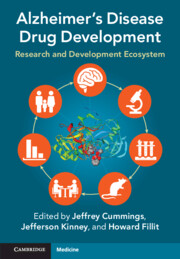Book contents
- Alzheimer’s Disease Drug Development
- Alzheimer’s Disease Drug Development
- Copyright page
- Dedication
- Contents
- Contributors
- Foreword
- Acknowledgments
- Section 1 Advancing Alzheimer’s Disease Therapies in a Collaborative Science Ecosystem
- 1 Alzheimer’s Disease Drug Development: A Research and Development Ecosystem
- 2 Drug Development for Alzheimer’s Disease: An Historical Perspective
- 3 Alzheimer’s Disease Drug Discovery in Academia: From High-Throughput Screening to In Vivo Testing
- 4 The Harrington Discovery Institute and Alzheimer’s Disease Drug Development
- 5 Repurposed Agents in Alzheimer’s Disease Drug Development
- 6 Artificial Intelligence in Alzheimer’s Drug Discovery
- Section 2 Non-clinical Assessment of Alzheimer’s Disease Candidate Drugs
- Section 3 Alzheimer’s Disease Clinical Trials
- Section 4 Imaging and Biomarker Development in Alzheimer’s Disease Drug Discovery
- Section 5 Academic Drug-Development Programs
- Section 6 Public–Private Partnerships in Alzheimer’s Disease Drug Development
- Section 7 Funding and Financing Alzheimer’s Disease Drug Development
- Index
- References
4 - The Harrington Discovery Institute and Alzheimer’s Disease Drug Development
from Section 1 - Advancing Alzheimer’s Disease Therapies in a Collaborative Science Ecosystem
Published online by Cambridge University Press: 03 March 2022
- Alzheimer’s Disease Drug Development
- Alzheimer’s Disease Drug Development
- Copyright page
- Dedication
- Contents
- Contributors
- Foreword
- Acknowledgments
- Section 1 Advancing Alzheimer’s Disease Therapies in a Collaborative Science Ecosystem
- 1 Alzheimer’s Disease Drug Development: A Research and Development Ecosystem
- 2 Drug Development for Alzheimer’s Disease: An Historical Perspective
- 3 Alzheimer’s Disease Drug Discovery in Academia: From High-Throughput Screening to In Vivo Testing
- 4 The Harrington Discovery Institute and Alzheimer’s Disease Drug Development
- 5 Repurposed Agents in Alzheimer’s Disease Drug Development
- 6 Artificial Intelligence in Alzheimer’s Drug Discovery
- Section 2 Non-clinical Assessment of Alzheimer’s Disease Candidate Drugs
- Section 3 Alzheimer’s Disease Clinical Trials
- Section 4 Imaging and Biomarker Development in Alzheimer’s Disease Drug Discovery
- Section 5 Academic Drug-Development Programs
- Section 6 Public–Private Partnerships in Alzheimer’s Disease Drug Development
- Section 7 Funding and Financing Alzheimer’s Disease Drug Development
- Index
- References
Summary
Until recently, only five medicines have been approved for treatment of patients with Alzheimer’s disease (AD). Unfortunately, these agents offer just mild and temporary symptomatic improvement, without slowing progression of the disease itself. The Harrington Discovery Institute of University Hospitals Health System in Cleveland addresses this problem through a unique model that advances a diversified portfolio of new medicines for both treatment and prevention of AD. The institute identifies academic scientists in the USA, UK, and Canada who have made exceptionally innovative basic science discoveries related to AD and provides them with both financial support and critical programmatic direction. This latter contribution entails guidance and oversight from eminent drug developers whose collective expertise would normally only be available within a large pharmaceutical company. This enables academic scientists to bridge the “valley of death” between their scientific discoveries and development of medicines. As a result, HDI is bringing new medicines with novel mechanisms of action into the clinic for Alzheimer’s disease.
Keywords
- Type
- Chapter
- Information
- Alzheimer's Disease Drug DevelopmentResearch and Development Ecosystem, pp. 45 - 53Publisher: Cambridge University PressPrint publication year: 2022

